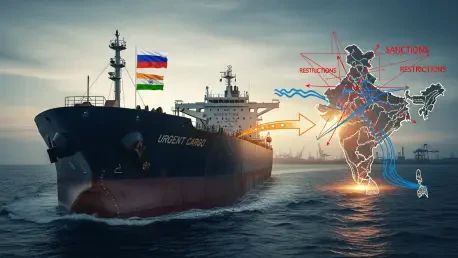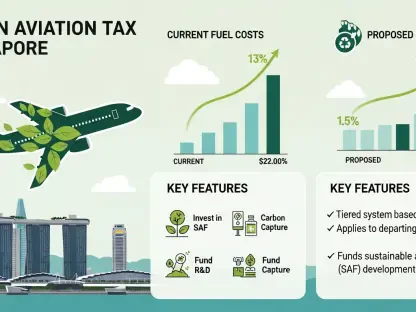What happens when a global energy giant faces unprecedented restrictions, and one of its largest markets begins to waver under pressure? The dramatic tripling of discounts on Russian Urals crude at Indian ports paints a stark picture of a trade relationship caught in the crosshairs of geopolitics. With U.S. sanctions tightening their grip on major Russian oil firms, the once-thriving flow of discounted oil to India is facing new turbulence, raising questions about energy security, pricing strategies, and the resilience of international alliances in a fractured global market.
The significance of this shift cannot be overstated. India has emerged as a cornerstone for Russian oil exports since Western bans redirected energy flows toward Asia. Yet, with the latest sanctions targeting industry giants like Lukoil and Rosneft, Indian refiners are stepping back, creating a ripple effect across pricing and supply chains. This story matters not just for energy analysts but for anyone tracking the delicate balance of global trade and the far-reaching impact of geopolitical decisions on everyday fuel costs.
A Shifting Energy Landscape Under Pressure
The global energy market is undergoing a seismic transformation as U.S. sanctions reshape the dynamics of Russian oil exports. Once a reliable supplier to Europe, Russia has pivoted to Asian markets, with India becoming a key destination for its discounted Urals crude. However, the recent surge in discounts—now reaching $5 to $6 per barrel below dated Brent—signals a troubling decline in demand from Indian buyers, driven by the toughest sanctions yet on Russia’s energy sector.
These restrictions have introduced a new layer of uncertainty into an already volatile market. Major Indian refiners, wary of compliance deadlines such as the one set for November 22, are reevaluating their purchasing decisions. The result is a market in flux, where pricing strategies and logistical maneuvers are being tested against the backdrop of international pressure, forcing both nations to adapt to rapidly changing circumstances.
This evolving landscape highlights broader implications for energy trade. As sanctions disrupt traditional flows, the balance of power in global oil markets is shifting, with discounted crude becoming both a lifeline for Russia and a point of contention for buyers navigating geopolitical risks. The stakes are high, and the outcomes of these tensions could redefine trade patterns for years to come.
Why Russian Oil and India’s Role Matter Now
India’s position as a critical buyer of Russian oil has taken center stage in the wake of Western restrictions. With the European Union’s ban on Russian energy imports redirecting supply chains, India has absorbed a significant share of Urals crude, benefiting from lower prices to meet its growing energy demands. This relationship has been a vital outlet for Russia to sustain export volumes despite mounting isolation from traditional markets.
However, the latest U.S. sanctions on key Russian oil companies have cast a shadow over this partnership. The measures, aimed at curbing Russia’s financial lifelines, have created hesitation among Indian buyers, who now face the challenge of balancing economic incentives with compliance risks. For global observers, this dynamic underscores how sanctions can alter not just bilateral trade but also the stability of energy supplies in major economies.
Beyond immediate trade concerns, this situation reflects a larger geopolitical chess game. India’s role as a major consumer of discounted oil positions it at the intersection of energy needs and international diplomacy, making its decisions a barometer for how emerging markets respond to Western policy pressures. The fallout from these sanctions could influence future alignments in the global energy sphere.
Unpacking the Impact of U.S. Sanctions on Trade Dynamics
The multifaceted effects of U.S. sanctions on Russian oil trade with India are evident across several dimensions. Discounts on Urals crude have skyrocketed, moving from a modest $1 to $2 per barrel below dated Brent in August to a staggering $5 to $6 today, reflecting a sharp drop in appetite among Indian refiners. This pricing shift is a clear indicator of the market’s reaction to heightened geopolitical risks.
Major industry players are feeling the strain, with Reliance Industries, India’s largest private refiner, suspending purchases at its Jamnagar complex as of November 20. This pullback, driven by looming deadlines to cease dealings with sanctioned producers, illustrates the tangible impact of policy on operational decisions. Such moves by key refiners signal a broader trend of caution that could further depress demand for Russian crude.
Despite these challenges, Russia demonstrates remarkable resilience in maintaining export levels. Near-peak volumes from western ports persist, supported by OPEC+ output allowances and domestic refinery disruptions due to external conflicts. Yet, financial pressures are undeniable, as evidenced by aggressive discounting, while logistical workarounds like the use of a “shadow fleet” of vessels and stable freight costs—around $7.5 million for an Aframax tanker from Baltic ports—keep shipments viable, even as Urals trades below the EU’s $60 per barrel price cap.
Voices from the Market and Expert Insights
Market participants and analysts are sounding alarms over the intensifying pressures from U.S. sanctions. One energy market expert commented, “The widening discounts on Urals crude are a stark reflection of buyer reluctance in India, where the risks of geopolitical fallout now eclipse the appeal of bargain prices.” This sentiment captures the growing unease among stakeholders navigating an increasingly complex trade environment.
Further insights reveal the depth of Russia’s strategic adjustments. Trade data indicates a calculated free-on-board price of approximately $20 per barrel at Russian ports, underscoring Moscow’s efforts to mitigate losses through deep discounts. Combined with real-time market responses, such as Reliance Industries’ halt on imports, these figures paint a picture of a trade relationship strained by external forces yet sustained by tactical pricing maneuvers.
The consensus among industry watchers is that while the sanctions are biting, they have not yet severed the ties between Russia and India. The use of alternative shipping mechanisms and the stability of freight rates suggest a degree of adaptability, though the long-term viability of such measures remains uncertain. These perspectives highlight a critical juncture where immediate survival strategies clash with looming sustainability concerns.
Navigating the Future: Strategies for Stakeholders
As the energy trade between Russia and India grapples with the fallout from U.S. sanctions, stakeholders must adopt proactive measures to address emerging challenges. Indian refiners are advised to closely monitor fluctuations in Urals crude discounts, identifying opportunities for cost-effective purchases while ensuring adherence to international compliance frameworks. This balancing act is essential for maintaining operational stability.
Diversification of supply chains offers another pathway forward. By exploring alternative oil sources from regions like the Middle East or Africa, India can reduce its dependence on Russian crude, thereby mitigating risks tied to geopolitical uncertainties. Such a strategy would bolster energy security and provide a buffer against sudden market disruptions caused by policy shifts.
Additionally, both Russian exporters and Indian buyers should assess the durability of current logistical solutions, such as shadow fleet operations, while keeping an eye on freight cost trends. Engaging in policy dialogue with governments and industry bodies to clarify compliance deadlines and reduce market ambiguity is equally vital. These steps, taken collectively, can help navigate the turbulent waters of a sanctions-driven energy landscape, ensuring adaptability and resilience for all parties involved.
Looking back, the saga of U.S. sanctions on Russian oil trade with India unfolded as a defining chapter in global energy dynamics. The tripling of discounts and the hesitance of major refiners marked a turning point, revealing the profound influence of geopolitical policies on market behaviors. Moving forward, actionable strategies became imperative—stakeholders needed to prioritize diversified sourcing, rigorous monitoring of pricing trends, and collaborative policy efforts to stabilize trade. The lessons from this period underscored the importance of agility and foresight, urging nations and companies alike to prepare for future uncertainties with robust contingency plans and a commitment to sustainable energy partnerships.









